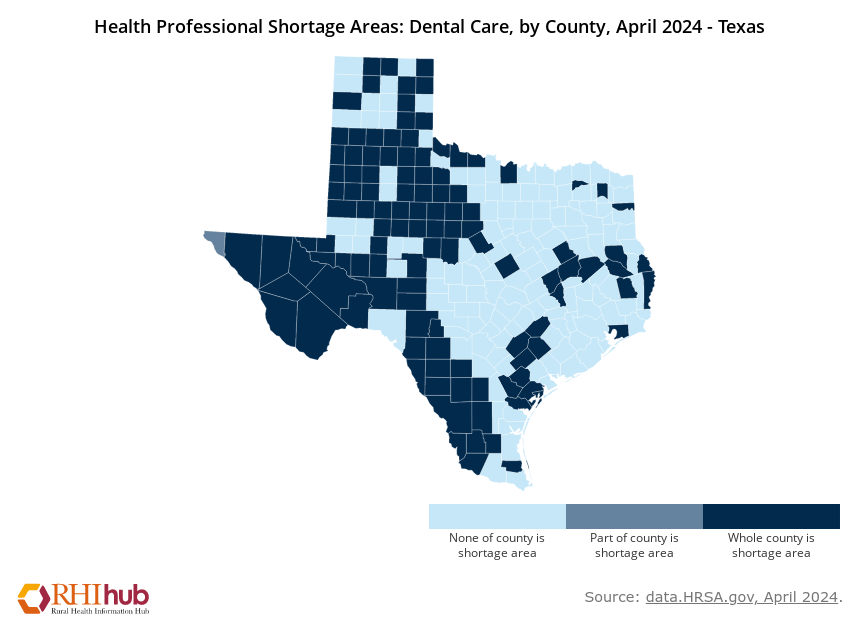Access to CareTexas
Dental Health Professional Shortage Areas
HRSA identifies areas where populations or facilities are experiencing a shortage of health care services.
There are several types of shortage designations. For more information, visit HRSA’s definition page.
Health Professional Shortage Areas have a shortage of primary, dental, or mental health care providers. The charts below and at right show shortages of dental care.
TEXAS HAS 316 TOTAL DENTAL CARE HPSA DESIGNATIONS WITH AROUND 3.2 MILLION TEXANS LIVING IN THOSE DHPSA AREAS.
Click maps to enlarge.
Texas Border counties were more likely than other counties in the border states to be whole- or partial county dental care health professional shortage areas (DHPSA). Only one border county had no shortage indicator for dental care, versus 27.2% among non-border counties. Conversely, 79.6% of border counties, versus 52.5% of other counties, were whole-county DHPSAs.
— 2021 Rural Border Health Chartbook, Dental Care Health Professional Shortage Area Status, pg. 18.
Health Care Workforce
In Texas there are 54.2 dentists per 100,000 population.
| Texas | Total US | |
| 2004 | 9,954 | 169,765 |
| 2005 | 10,156 | 171,586 |
| 2006 | 10,328 | 172,638 |
| 2007 | 10,828 | 176,121 |
| 2008 | 11,082 | 178,399 |
| 2009 | 11,419 | 181,388 |
| 2010 | 11,938 | 183,212 |
| 2011 | 12,373 | 186,099 |
| 2012 | 12,805 | 188,884 |
| 2013 | 13,332 | 191,389 |
| 2014 | 13,657 | 192,271 |
| 2015 | 14,198 | 195,770 |
| 2016 | 14,499 | 196,468 |
| 2017 | 14,917 | 198,517 |
| 2018 | 15,184 | 199,486 |
| 2019 | 15,603 | 200,419 |
| 2020 | 15,872 | 201,117 |
| 2021 | 15,992 | 201,927 |
| 2022 | 16,324 | 202,536 |
| 2023 | 16,522 | 202,304 |
Source: American Dental Association, Health Policy Institute analysis of ADA masterfile.
Copyright © 2023 American Dental Association. All rights reserved.
General Dentists
Many of the general dentists in Texas are near the Houston area. However, compared to the population (per 100,000 people), the ratio of general dentists (per 100,000 people) are greater in the eastern region of the state.
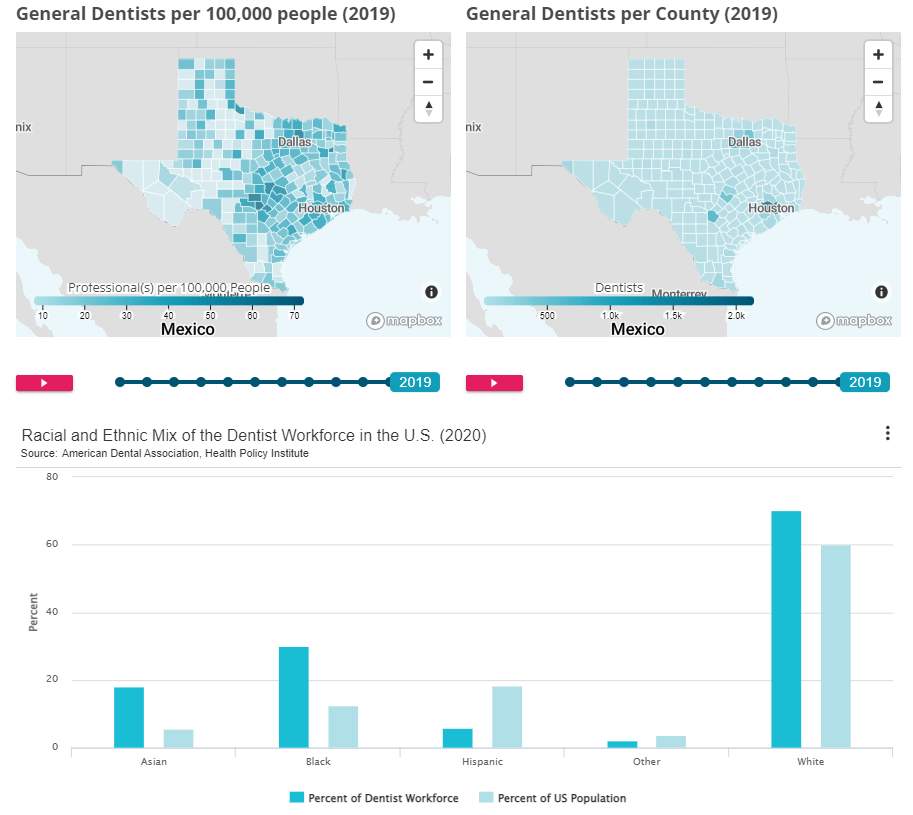
Dental Hygienists
Many of the dental hygienists in Texas are near the Houston and Dallas areas. However, compared to the population (per 100,000 people), the ratio of dental hygienists (per 100,000 people) are greater in the eastern region of the state.
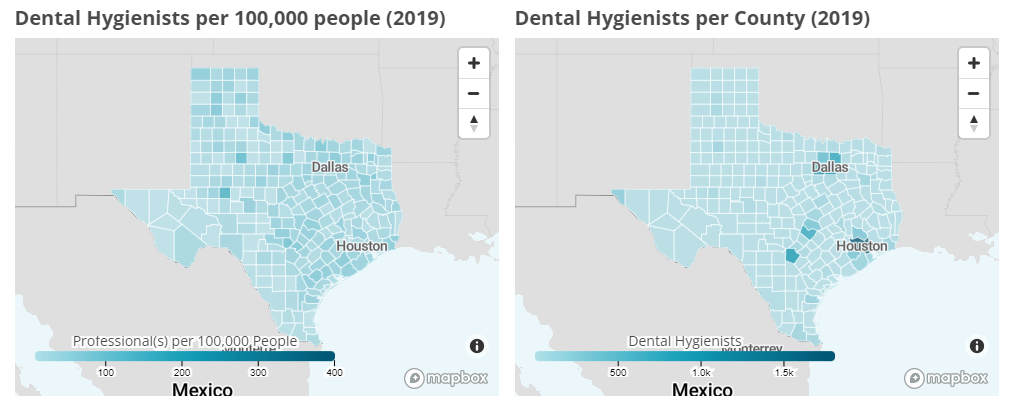
Dental Assistants
Many of the dental assistants in Texas are near the Houston and Dallas areas. However, compared to the population (per 100,000 people), the ratio of dental assistants (per 100,000 people) are greater in the eastern region of the state.
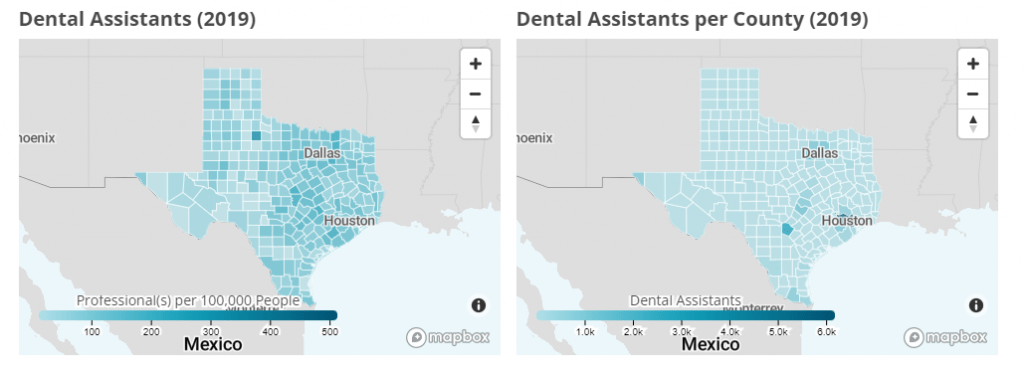
Dental Students in Texas
A little over half of the applicants to Texas dental schools are classified as in state, however over 90% of enrollees are classified as in state. Of the 2019 graduates, around 75% of those graduating from a Texas dental school plan to work in Texas after graduation.
Texas loses few students to other states, with Ohio (2.6%) being the highest percentage. Texas also receives more out of state graduated dentists with Rhode Island having the most come to Texas (33.3%).
Texas Dental Schools
Texas A&M University School of Dentistry
UTHealth Houston School of Dentistry
UT Health San Antonio School of Dentistry
Texas Tech University Health Sciences Center El Paso - Hunt School of Dental Medicine
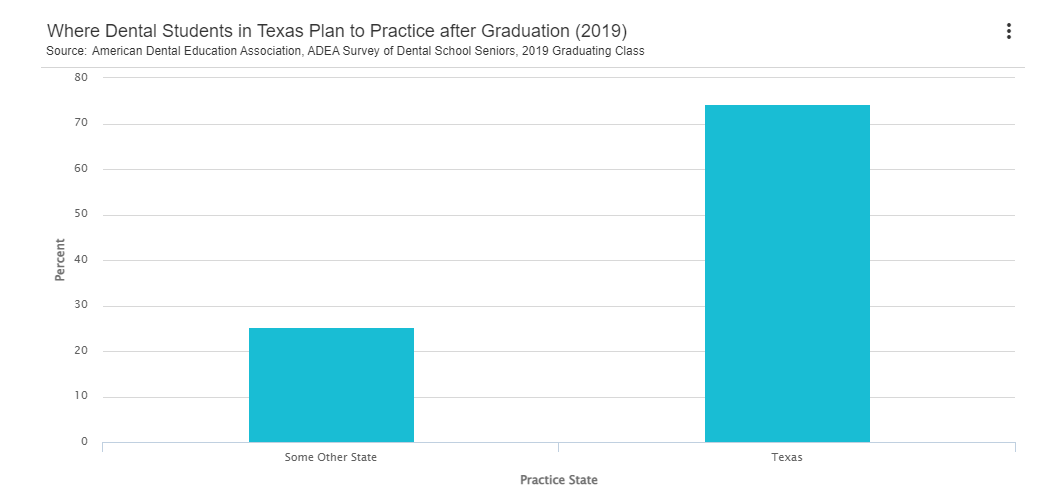

Health Insurance Coverage
Health Insurance Coverage
Health insurance coverage is an important determinant of access to health care. Uninsured children and nonelderly adults are substantially less likely to have a usual source of health care or a recent health care visit than their insured counterparts.
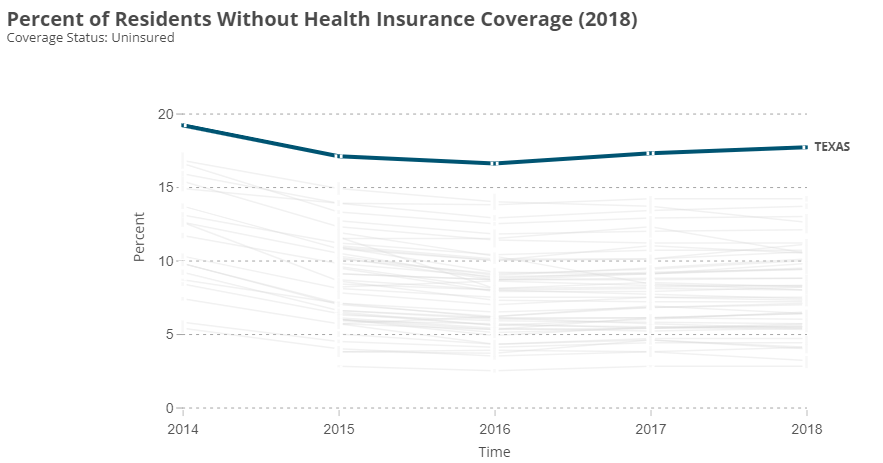
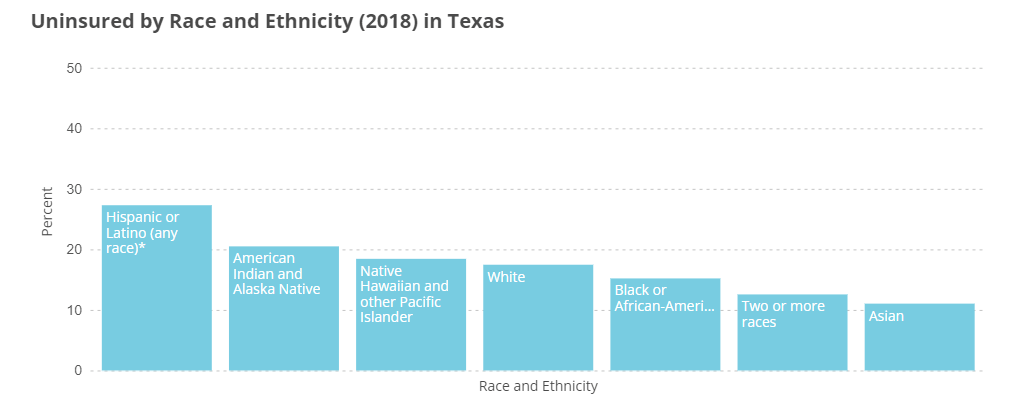
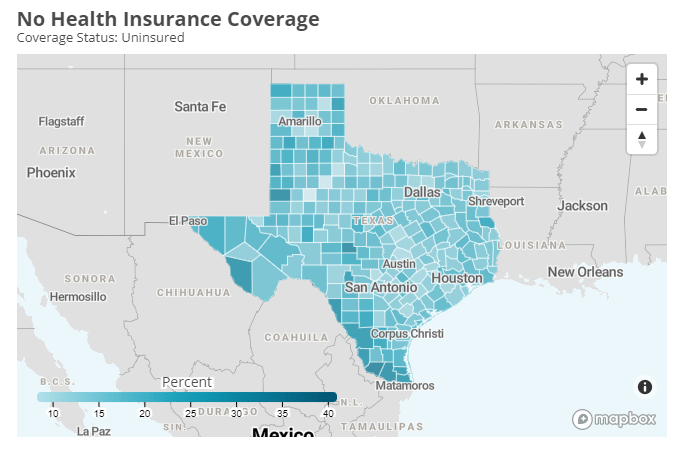
The major source of coverage for persons under age 65 is private employer-sponsored group health insurance. Individual and family private health insurance coverage can also be purchased either directly or through the Health Insurance Marketplace or state-based exchanges. Public programs, such as Medicaid and the Children’s Health Insurance Program, provide coverage for many low-income children and adults.
To develop policies and programs that improve health insurance coverage, obtaining timely and accurate information on the number of persons who lack health insurance coverage and the number of persons with different types of coverage is important. (Source: CDC)

Uninsured and in Need
"68.5 Million Lack Dental Insurance, More May Be Coming.
According to the 2023 State of Oral Health Equity in America survey from CareQuest Institute, an estimated 68.5 million adults do not have dental insurance. The survey is the largest nationally representative, annual survey focused exclusively on adults’ knowledge, attitudes, experiences, and behaviors related to oral health."
Dental Care Cost Barriers and Care Utilization in the United States
Dental Care Cost Barriers and Care Utilization in the United States

Texas Medicaid Enrollment
Most Texans who are enrolled in Medicaid receive coverage through the STAR managed care program. STAR covers low-income children, pregnant women and families. Dental benefits include regular dental exams and, if needed, fillings to address decay. Compared to U.S. dentists as a whole, Texas dentists are more likely to see Medicaid patients. And it's also good to know that Texas children enrolled in Medicaid are more likely to see a dentist regularly than kids in all other states.
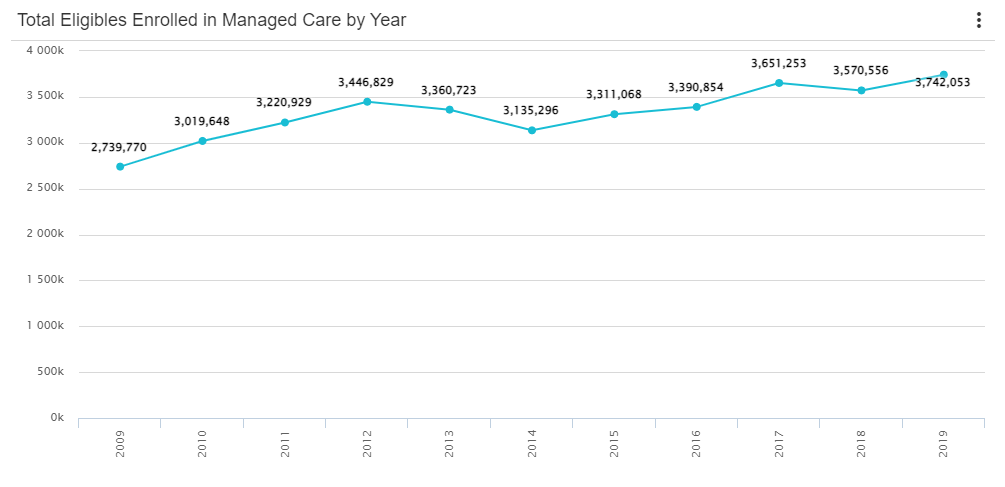
Health Care Provider Visits
Data from the CDC's Behavioral Risk Factor Surveillance System (BRFSS), and the National Survey of Drug Use and Health (NSDUH), indicate how often state residents receive medical care.
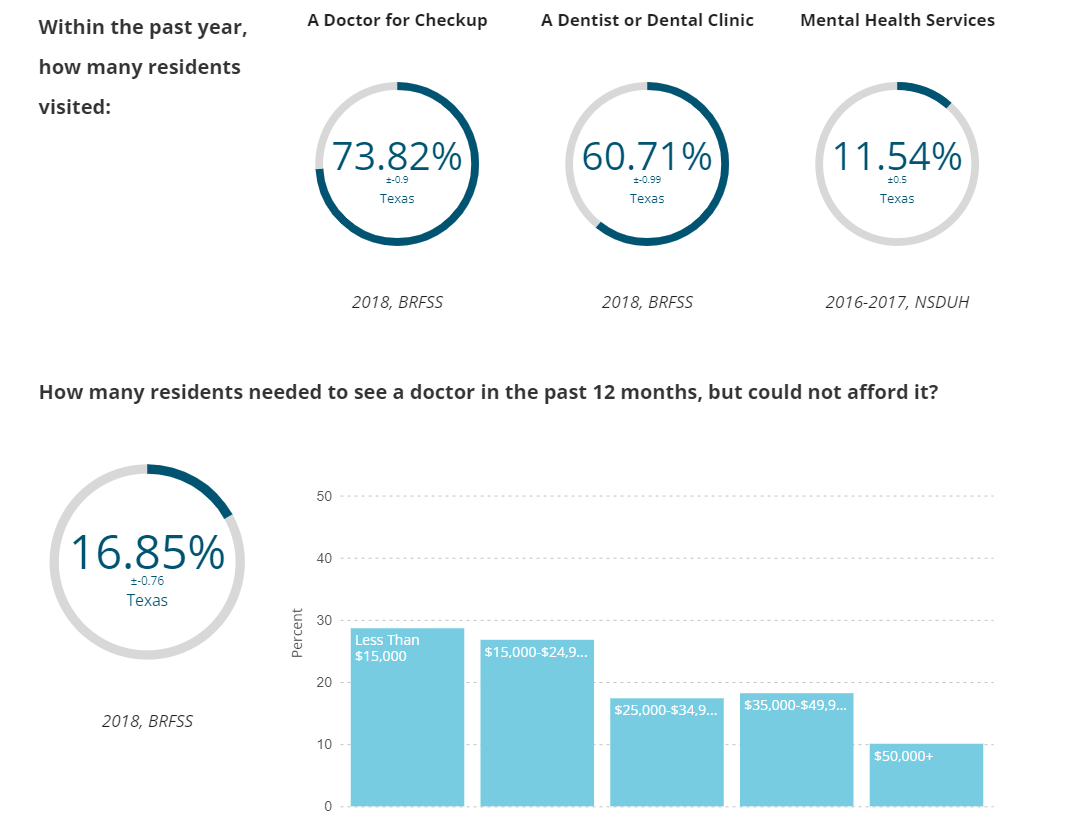
Across the four border states, 64.3% of adults reported that they had visited a dentist during the
past year, with border residents being less likely to have seen a dentist than non-border residents.
Hispanic adults living in border counties were less likely than other adults to report having seen a dentist in the past year. Rural residents were disadvantaged in dental visits, regardless of Hispanic identification.
— 2021 Rural Border Health Chartbook, Dental Care Health Professional Shortage Area Status, pg. 25.
About the Data
Health Professional Shortage Areas: Data are from the Rural Health Information Hub, Health Professional Shortage Areas: Dental Care, by County, 2023 - Texas the data source is data.HRSA.gov, May 2023. Border data are from the Rural and Minority Health Research Center's 2021 Rural Border Health Chartbook.
Health Care Workforce: Shortage/Surplus and data are from Texas Health and Human Services Supply and Distribution Tables for State-Licensed Health Professions in Texas. Supply of Dentists and Dentist demographic data are from American Dental Association, Health Policy Institute (ADA HPI) Supply of Dentists in the U.S., 2001-2022 (XLSX) report and the ADA HPI US Dentist Demograhic Dashboard. Dentist supply data are from Texas Health and Human Services Supply and Distribution Tables for State-Licensed Health Professions in Texas.
Dental Students in Texas: Data are from the American Dental Education Association (ADEA). Dental school application and enrollment data are from U.S. Dental School Applicants and Enrollees, 2022 Entering Class. Dental school graduates data are from ADEA Survey of Dental School Seniors, 2019 Graduating Class.
Health Insurance Coverage: Data are from the American Community Survey, Table S2701. The percentage denominator is the population of noninstitutionalized civilians. Data for locations with populations under 60,000 are only available in 5-year estimates.
Cost Barriers to Dental Care: Data are from the report "Cost Barriers to Dental Care Among the U.S. Population, by Race and Ethnicity", published by the American Dental Association's Health Policy Institute.
Dental Visits: Data are from the report "Dental Care Utilization Among the U.S. Population, by Race and Ethnicity", published by the American Dental Association's Health Policy Institute.
Texas Medicaid Enrollment: Data are from Medicaid.gov's Managed Care Enrollment Summary.
Racial and Ethnic Mix of Dentists: Data are from the report "Racial and Ethnic Mix of the Dentist Workforce in the U.S.", published by the American Dental Association's Health Policy Institute.
Health Care Provider Visits: Data about dentist and doctor visits are from the CDC's Behavioral Risk Factor Surveillance System (BRFSS). Data about mental health service visits are from the National Survey on Drug Use and Health, conducted by the Substance Abuse and Mental Health Services Administration. Border data are from the Rural and Minority Health Research Center's 2021 Rural Border Health Chartbook.
More Workforce and Access to Care Resources may be found on our Workforce Resource Page.
Registration is open for the 2024 Texas Oral Health Conference being held in Austin, TX on August 2, 2024.

